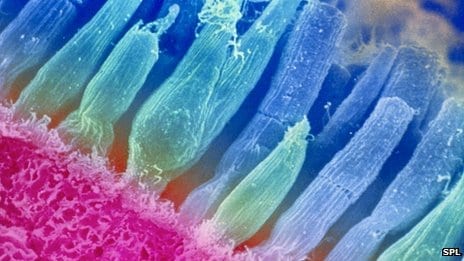
A family of molecules developed at Carnegie Mellon University to break down pollutants in water is one step closer to commercial use.
Study results published online in the journal Green Chemistry show that the molecules, which are aimed at removing hazardous endocrine disruptors from water sources, aren’t endocrine disruptors themselves as they proved to be non-toxic to developing zebrafish embryos.
Created by Carnegie Mellon green chemist Terry Collins, the molecules, called TAML® activators, provide an environmentally friendly method for breaking down toxic compounds that contaminate water, including endocrine disruptors. Endocrine disrupters, which are found in almost 25 percent of our streams, rivers and lakes, can disrupt the normal functions of the endocrine system by mimicking or blocking the activities of hormones in wildlife leading to impaired development. While the connections between the adverse effects of endocrine disrupting water contaminants on aquatic organisms and human health have yet to be established, animal studies suggest that endocrine disruptors may be involved in a host of modern-day health epidemics including cancers, learning disabilities, obesity, and immune and reproductive system disorders.
Certain medications are designed to disrupt the endocrine system, such as birth control pills and breast and prostate cancer drugs. In some cases, people taking these drugs excrete a significant amount of the active ingredients into wastewater. Concentrated animal feeding operations also release a multitude of veterinary drugs and artificial and natural hormones into bodies of water. The toxic molecules then contaminate our waterways in part because they are not cleared by conventional wastewater treatment approaches.
“Fish in rivers and lakes can be adversely affected by even minute traces of ethinylestradiol, an artificial estrogen found in birth control pills. In what is a worldwide problem, male fish become more feminine, which impairs their ability to reproduce and contributes to declining fish populations,” Collins said.
In previous work, Collins and his collaborators showed that TAMLs used with hydrogen peroxide can easily and efficiently remove steroid hormones, including ethinylestradiol, from water after one treatment.
“Quite a few common commercial chemicals cause endocrine disruption,” said Collins, the Teresa Heinz Professor of Green Chemistry. “Before TAML activators are commercialized for treating municipal water, it is important to be sure that they aren’t introducing into the water the very problem they were designed to reduce or eliminate.”
In the current study, the research groups of Carnegie Mellon’s Collins and Oregon State University‘s Robert L. Tanguay tested several TAML activators to determine whether they exhibit any endocrine disrupting ability. Using zebrafish as a model system, the researchers exposed the fish embryos to seven different types of TAML activators. The embryos used in the study had had their outer membrane, called the chorion, removed to heighten their sensitivity to chemicals. At the concentrations typically used for decontaminating water, none of the TAMLs impaired embryo development. Collins said at higher concentrations three of the TAMLs impaired development, indicating that they should be avoided for use in water treatment.
The researchers also looked at the relationship between the chemical structure of the TAML activators and the level of toxicity.
“We found that certain structural features of the TAML activators led to a higher degree of toxicity. This knowledge can guide the redesign or design of new TAML molecules that are not toxic to fish or other wildlife,” Collins said. “Fortunately, the most useful catalysts for treating water exhibited the lowest toxicity.”
The Latest Bing News on:
Chemicals That Break Down Water Contaminants
- ‘Not a finish line’: For water providers, new PFAS rule is first stepon April 30, 2024 at 6:30 pm
Eight county water systems have some PFAS, though the state deems them safe. Many smaller systems still lack protection.
- Regulators took aim at two water contaminants recently. But do regs go far enough or target the right players?on April 30, 2024 at 9:23 am
Water systems will need to comply with new rules on contaminants at the state and federal levels after two regulations were approved this month. That could bring challenging costs to water providers.
- EPA sets new limit on 'forever chemicals' in drinking wateron April 29, 2024 at 5:13 pm
Polyfluoroalkyl substances (PFAS), also known as 'forever chemicals', do not break down and can persist in water and soil.
- EPA Acts Swiftly to Address PFAS Contaminationon April 29, 2024 at 5:00 pm
Known as “forever chemicals,” PFAS are a category of chemicals that do not break down in the environment ... Those systems with contamination exceeding the MCLs will be required to take steps to ...
- Virginia lab wins federal grant to break down forever chemicalson April 29, 2024 at 1:33 pm
The EPA now requires water treatment plants to test for a group of contaminants known as "forever chemicals." Used in products like non-stick coatings and rain wear, these substances are water, grease ...
- Crackdown on PFAS: What to know about the ‘forever chemicals’ in everyday useon April 26, 2024 at 4:03 pm
The Biden administration is tightening the screws on "forever chemicals" used in the production of a wide range of consumer goods.
- Limits on PFAS in Drinking Water to Benefit 100M Americanson April 24, 2024 at 5:00 pm
Forever chemicals break down in the environment very slowly ... Works facility contribute to widespread PFAS contamination of the region’s water and food supplies. Biden Administration officials ...
- Breaking Down New Rules About ‘Forever Chemicals’on April 24, 2024 at 12:00 am
Lisa Friedman, who covers climate change, discussed the fight to regulate toxic chemicals found in nearly half of America’s tap water.
- EPA Standard Tackles Dangerous Forever Chemicals In Our Water Supplyon April 23, 2024 at 3:00 am
Forbes published a shocking headline: "Nearly half of U.S. tap water has PFAs: Here’s Why ‘Forever Chemicals’ Are Dangerous." ...
- Camanche water tests free of 'forever chemicals'on April 20, 2024 at 8:59 pm
Testing conducted by Barr Engineering last month showed no detectable levels of PFAS contamination present in Camanche's water system. "Having established our existing deep well with a new pump and ...
The Latest Google Headlines on:
Chemicals That Break Down Water Contaminants
[google_news title=”” keyword=”Chemicals That Break Down Water Contaminants” num_posts=”10″ blurb_length=”0″ show_thumb=”left”]
The Latest Bing News on:
Endocrine disruptors
- Study links endocrine-disrupting chemical exposure to poorer sleep and vitamin D deficiencyon April 30, 2024 at 5:09 pm
Study in the journal Nutrients links exposure to endocrine-disrupting chemicals with vitamin D deficiency and reduced sleep duration, suggesting a compounded negative impact on health.
- What Are Endocrine Disruptors and How Do They Impact Hormones?on April 30, 2024 at 2:11 pm
The Unconventional Dietitian, stopped by News15 at Noon to share the details on endocrine disruptors. She explains what they are and how they impact our hormones.
- 6 toxic chemicals we’re exposed to daily and how to avoid themon April 30, 2024 at 11:16 am
Everyday products containing hazardous chemicals could jeopardize our health. Here are six examples and strategies to reduce exposure to them.
- Data scarcity challenges identification of endocrine disruptorson April 30, 2024 at 11:06 am
Lack of data from the chemical industry in the EU often prevents the assessment of whether substances, for example, used in consumer products, are endocrine disrupting. This is shown in a new study ...
- Identification of endocrine disruptors hampered by data scarcity: Reporton April 30, 2024 at 10:34 am
Lack of data from the chemical industry in the EU often prevents the assessment of whether substances, for example, used in consumer products, are endocrine disrupting.
- Cancer-causing substances detected in 38 kid products sold on AliExpress, Temuon April 29, 2024 at 10:50 pm
High levels of chemicals known to cause cancer have been found in 38 products for kids available on the Chinese shopping apps of AliExpress and Temu for South Korean customers, the customs agency said ...
- 6 million healthcare workers call for stricter limits on global plasticson April 29, 2024 at 8:33 am
Millions of healthcare workers around the world are calling for world governments to put significant limits on the plastics industry. Representatives of 900 healthcare civil society groups called ...
- Why a new organic produce shopping guide is helpful, not fearfulon April 29, 2024 at 6:00 am
Registered dietitian nutritionist Carrie Dennett breaks down a new "organic vs. conventional" produce shoppers guide from Consumer Reports.
- Endocrine Disruptors Pose Challenges for Human Healthon April 18, 2024 at 6:01 am
A wealth of data shows that endocrine-disrupting compounds are a constant, multifaceted, and pervasive health risk.
- Endocrine-disrupting compounds found in 4 rivers in NCR, Region 3—UP studyon March 26, 2024 at 9:03 am
E1, or estrone, is a hormone that can induce endocrine-disrupting effects even at low concentrations of long-term exposure, such as fertility issues in aquatic organisms. E1 is the only hormone ...
The Latest Google Headlines on:
Endocrine disruptors
[google_news title=”” keyword=”endocrine disruptors” num_posts=”10″ blurb_length=”0″ show_thumb=”left”]










